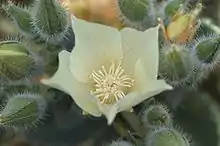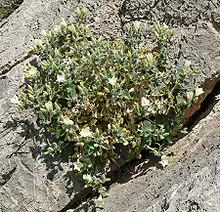| Desert rock nettle | |
|---|---|
 | |
| Scientific classification | |
| Kingdom: | Plantae |
| Clade: | Tracheophytes |
| Clade: | Angiosperms |
| Clade: | Eudicots |
| Clade: | Asterids |
| Order: | Cornales |
| Family: | Loasaceae |
| Genus: | Eucnide |
| Species: | E. urens |
| Binomial name | |
| Eucnide urens Parry, 1875 | |
Eucnide urens, also known as desert rock nettle or desert stingbush, is a shrub which is native to desert areas in California, Arizona, Utah, Southern Nevada, and Baja California. Other common names are velcro plant[1] and vegetable velcro.[2]
The flowers, which appear from spring to early summer, are cream or pale yellow with 5 petals and are 2.5 to 5 cm long. The coarsely serrated leaves are 2 to 6.5 cm long with stinging hairs which are also found on the stems and buds. It grows in the desert on cliffs and dry, rocky places.[3]
The plant is round and bushy and is usually between 30 and 60 cm in height and is often found on cliff faces. Desert bighorn sheep feed on the flowers.
Notes
- ↑ "The California Native Plant Society, Vol. 21, No. 3, May 2001" (PDF). 2001. Retrieved 2008-11-22.
- ↑ Hall, p. 154
- ↑ "Lady Bird Johnson Wildflower Center - The University of Texas at Austin". www.wildflower.org. Retrieved 2022-04-15.
References
Wikimedia Commons has media related to Eucnide urens.
- Spellenberg, R. (1979) Field Guide to North American Wildflowers - Western Region, National Audubon Society.
- Hall, Clarence A., Jr. (1991) Natural History of the White-Inyo Range, University of California Press.

In natural habitat in the Las Vegas Valley, Nevada
This article is issued from Wikipedia. The text is licensed under Creative Commons - Attribution - Sharealike. Additional terms may apply for the media files.